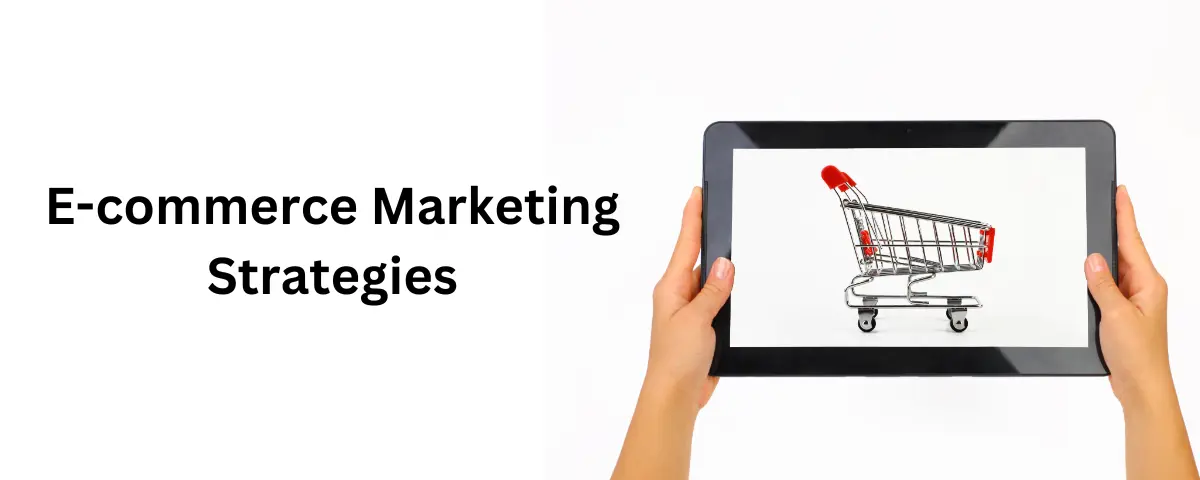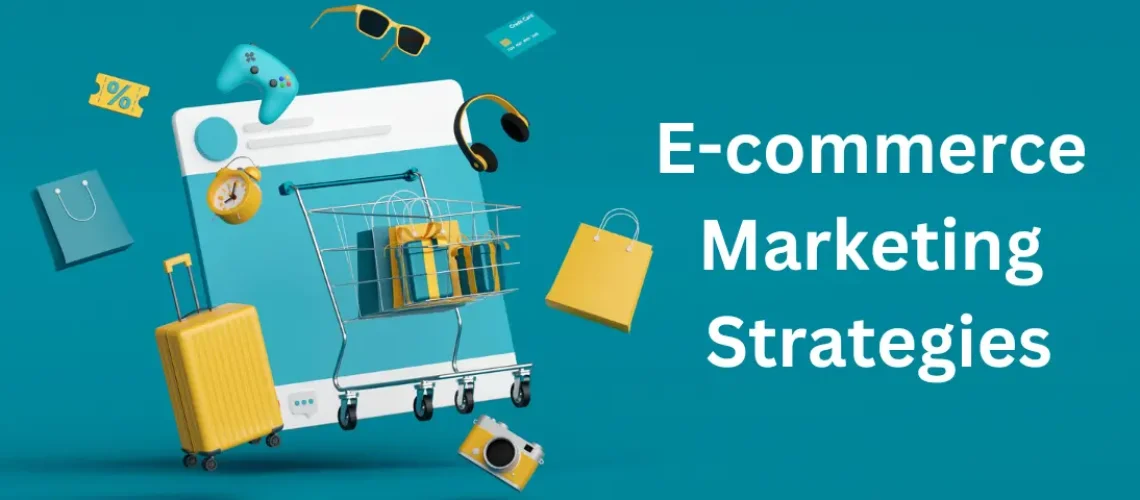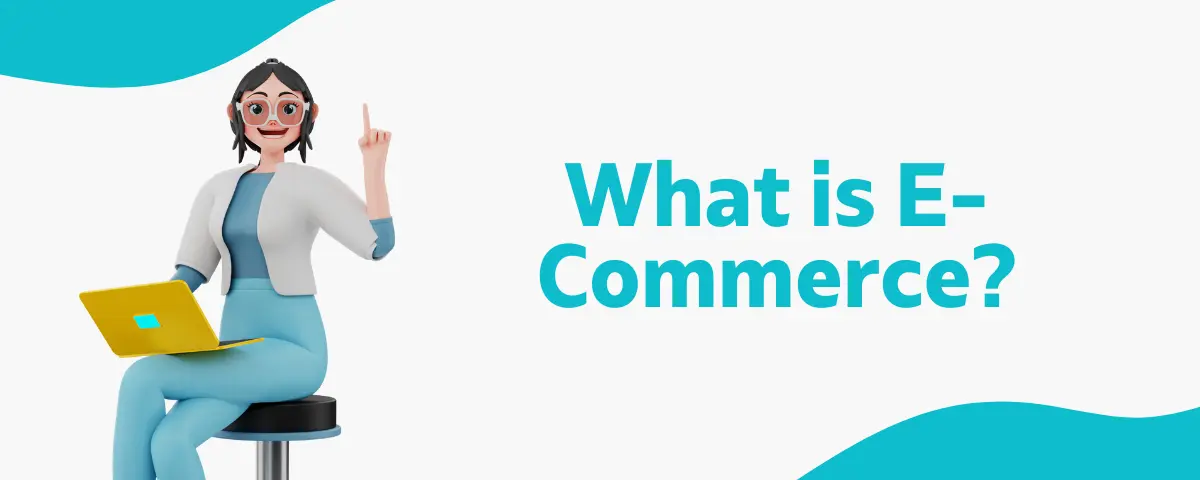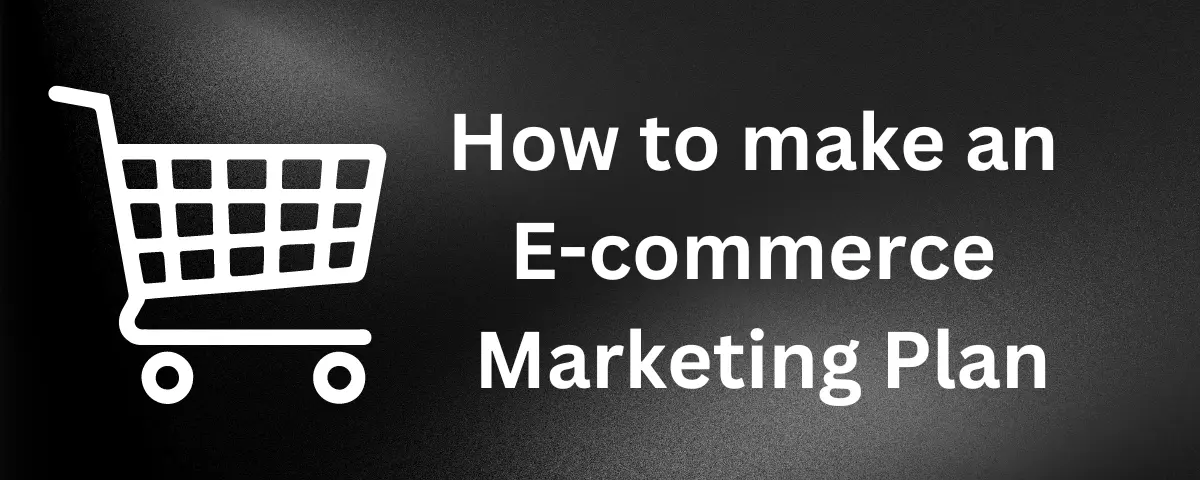Every online store that wants to boost sales needs to have a strong marketing plan as it is key for your business to succeed. With so many companies competing for customers online, it’s important to find ways to stand out and connect with the people you want to reach.
E-commerce marketing involves using different methods and tools to bring more visitors to your site, boost sales, and build relationships with customers that last. Some of these strategies include using social media, sending emails, making your website better, and looking at data and analytics.
In our comprehensive digital marketing course, we discuss various e-commerce marketing strategies that can help you navigate the competitive online world and reach your business goals.
Whether you’re just starting or want to improve what you’re already doing, these tips will give you the knowledge you need to make smart choices and grow your e-commerce business.
What is E-commerce?
E-commerce, also known as electronic commerce, is the process of buying and selling goods and services online or through other electronic networks. It has transformed the way businesses function and how consumers shop, offering convenience, accessibility, and a worldwide reach.
With over 33% of the world’s population shopping online, eCommerce is now a $6 trillion industry and will reach the $8 trillion mark by 2027.
E-commerce transactions can involve different parties such as businesses, consumers, and even other businesses. These transactions can occur through websites, mobile apps, social media platforms, or other digital channels.
There are various types of e-commerce models, including:
- Business-to-Consumer (B2C): This is the most widely used e-commerce model, where businesses sell products or services directly to consumers. Examples include online retailers such as Amazon or business owners with their e-commerce websites.
- Business-to-Business (B2B): This model involves businesses selling goods or services to other businesses. It typically includes transactions between manufacturers, wholesalers, and retailers.
- Consumer-to-Consumer (C2C): C2C e-commerce refers to individuals selling products or services to other individuals. Online marketplaces such as eBay or classified ads platforms help facilitate these transactions.
- Direct-to-Consumer (D2C): refers to businesses that create products and sell them directly to customers, without using traditional retail channels. This model has become increasingly popular with the growth of e-commerce platforms and the use of social media marketing.
What is E-commerce Marketing?
E-commerce marketing is the strategy of advertising and selling goods or services over the Internet. It involves attracting visitors to an online store and converting them into customers using a range of digital marketing strategies and tactics.
This form of marketing includes using digital platforms like social media, email, and search engines to connect with potential customers. It is focused on attracting visitors to e-commerce websites or platforms, boosting brand recognition, and ultimately boosting sales.
When you leverage these strategies, businesses can enhance their visibility, engage with potential buyers, and ultimately drive more sales.
15 E-commerce Marketing Strategies for Your Business

Get 50% Discount to Master ALL Aspects of Digital Marketing That Can Earn You $2,500 - $5,000 a month (Even if you are a complete beginner!)
Our students that intentionally implement what they learn from our digital marketing course make back the entire course fee within a single month or more after completing our course because our course gives them many income generating options with unlimited earning potential with no age or location barrier. The best part is no technical skills are required.
An opportunity to change your lifestyle and make money working from anywhere in the world. The results our students get from our digital marketing course prove this could be applied to any market or country and that it is designed for any skill level and work background.
*By signing up, you agree to our privacy policy and terms of service.
The key to success in e-commerce marketing is to incorporate various strategies to attract, convert, and retain customers. It is important to analyze your audience and also tailor your approach accordingly.
Some of the ecommerce marketing strategies you can adopt for your business include:
#1. User-Generated Content (UGC)
User-generated content (UGC) has become a popular strategy for businesses seeking to connect with their audience in a genuine and meaningful manner. It includes any content created by your customers, such as reviews, photos, videos, and social media posts featuring your products.
Massive report that 81% of consumers say they trust user-generated video more than professionally created brand content or influencer marketing, and 85% say they rely on UGC video before making a purchase.
UGC not only builds trust but also encourages potential buyers to engage with your brand. When customers see real people using and enjoying your products, they’re more likely to feel confident in making a purchase.
To encourage UGC, consider running contests or campaigns that invite customers to share their experiences. You can also feature their content on your website or social media pages, giving them recognition and fostering a sense of community.
#2. Customer Loyalty Programs
Customer loyalty programs are widely used to maintain customer retention and drive sales growth. These programs often provide incentives or special offers to customers who show loyalty to a particular brand through repeat purchases.
These programs reward customers for their continued patronage, offering benefits such as exclusive discounts, early access to sales, or points for every purchase.
As an e-commerce business owner, introducing a loyalty program creates a sense of value and appreciation for your customers. They also encourage customers to keep coming back to your store, as they work towards earning rewards or maintaining their status within the program.
When designing your loyalty program, consider your target audience’s preferences and make it easy for them to participate and track their progress.
With a well-executed loyalty program, you can foster stronger relationships with your customers and drive more sales over time.
#3. Social Proof
Social proof is a powerful concept in e-commerce marketing. It refers to the idea that people are more likely to make a purchase when they see others doing the same. This can take many forms, such as customer reviews, testimonials, ratings, and endorsements from happy customers.
To leverage social proof, showcase positive reviews prominently on your product pages and social media. You can also highlight any awards or recognitions your products have received. Additionally, consider featuring photos or videos of real customers using your products, as this creates a relatable connection for potential buyers.
This validation from others can also provide reassurance to consumers that they are making a wise choice by choosing to purchase from your brand.
When you use social proof in your marketing campaigns, it can result in higher conversion rates and increased customer loyalty.
#4. Chatbot Marketing
Chatbots are automated tools that can interact with customers in real time, answering questions, providing product recommendations, and even assisting with purchases. When you use chatbots on your website or social media platforms, you can offer instant support, making it easier for customers to find what they need.
Jumia, a leading e-commerce platform in Nigeria, uses a chatbot to assist customers with their orders, product inquiries, and delivery status.
One of the great benefits of chatbots is that they are available 24/7, allowing you to assist customers outside of regular business hours. This can lead to increased customer satisfaction and higher conversion rates. When setting up a chatbot, make sure it’s user-friendly and capable of handling common inquiries.
This streamlined method not only enhances the customer experience but also allows you the business owner to save both time and resources.
#5. Pay-Per-Click Advertising

If your marketing goal is to enhance your online presence and attract visitors to your websites, Pay-Per-Click (PPC) advertising is the ecommerce marketing strategy to use.
With PPC, you create ads that appear on search engines and social media platforms, and you only pay when someone clicks on your ad. This makes it a cost-effective option for reaching potential customers who are actively searching for products like yours.
To start with PPC, pick keywords that your target audience is likely to search for. Write catchy ad copy that shows what makes your product special and includes a clear call to action, encouraging people to click on your ad.
By carefully managing your PPC campaigns and analysing the results, you can optimize your ads for better performance and maximize your return on investment.
#6. Upselling and Cross-selling
Upselling involves encouraging customers to purchase a higher-end version of a product they’re considering, while cross-selling suggests complementary items that go well with their chosen product.
For example, if a customer is looking at a laptop, you might recommend a more powerful model (upselling) or suggest a laptop case and mouse (cross-selling). These techniques not only increase your average order value but also help customers find products that better meet their needs.
To implement these strategies, consider using personalized recommendations based on customer behavior and previous purchases to suggest other items they can buy.
#7. Affiliate Marketing
Affiliate marketing is a collaborative approach to e-commerce marketing that can help you reach a wider audience and drive more sales. In this model, you partner with other businesses or individuals (known as affiliates) who promote your products in exchange for a commission on each sale they generate.
Affiliates can include bloggers, social media influencers, or even other e-commerce stores that have a relevant audience. By leveraging their existing platforms and relationships, you can tap into new markets and gain exposure to potential customers who may not have discovered your brand otherwise.
To set up an affiliate program, create clear guidelines and commission structures that incentivize affiliates to promote your products effectively. Provide them with engaging marketing materials, such as banners and product descriptions, to make it easy for them to showcase your offerings.
#8. Social Media Advertising
Social media advertising is a highly targeted and cost-effective way to reach potential customers for your e-commerce business. You can leverage the vast user data available on platforms like Facebook, Instagram, and Twitter to create ads that resonate with your target audience based on their interests, demographics, and online behavior.
Social media ads come in various formats, including images, videos, carousels, and story ads. These ads can be used to showcase your products, drive traffic to your website, or encourage specific actions like making a purchase or signing up for a newsletter.
With detailed targeting options and the ability to retarget users who have previously interacted with your brand, social media advertising allows you to optimize your campaigns for maximum impact.
#9. Video Marketing

Videos have become an increasingly popular way for consumers to learn about and interact with brands. Expert recommends that companies that use video marketing can grow their revenue 49% faster than those that don’t.
When you create high-quality product videos, it can provide potential customers with a better understanding of your offerings and help them make informed purchasing decisions.
Videos can be used to highlight product features, demonstrate how-to’s, or share customer testimonials. They can be shared on your website, social media channels, and even in email campaigns.
When done well, video marketing can increase dwell time on your site, boost engagement, and ultimately lead to more sales.
#10. Email Marketing
Email marketing is a powerful tool for e-commerce businesses, allowing you to connect directly with your customers through mail. It involves sending targeted messages to your email list, which can include newsletters, promotional offers, product updates, and personalized recommendations.
One of the key benefits of E-commerce emails is that they have one of the highest deliverability rates of 96%. When you provide valuable content and exclusive deals, you can keep your audience engaged and encourage repeat purchases.
Make sure you segment your email list based on customer behavior and preferences. This allows you to tailor your messages, making them more relevant and effective.
#11. Remarketing
Remarketing is another smart strategy that allows you to reconnect with potential customers who have previously visited your e-commerce site but didn’t make a purchase.
When targeted ads show to these users as they browse other websites or social media platforms, you can remind them of the products they viewed and encourage them to return to your store.
This approach is effective because it keeps your brand top-of-mind and helps to rekindle interest. You can use remarketing ads to highlight special offers, new arrivals, or even items left in their shopping cart.
To get started with remarketing, set up tracking codes on your website to identify visitors and create tailored ad campaigns that speak to their interests.
#12. Live chat support

Live chat support allows you to provide real-time assistance to visitors on your website, helping them with questions, concerns, or product inquiries as they shop. This immediate support can significantly improve the shopping experience and increase the likelihood of conversions.
By offering live chat, you demonstrate that you value your customers’ time and are committed to helping them. Many shoppers appreciate the convenience of getting answers quickly without having to navigate lengthy FAQs or wait for email responses.
To implement live chat effectively, ensure your team is trained to handle common inquiries and provide helpful, friendly service. You can also use chatbots for after-hours support or to assist with basic questions.
#13. Study the Competition
In the competitive world of e-commerce, it’s important to keep an eye on what your competitors are doing. You should analyze their marketing strategies, pricing, and customer reviews as it can provide valuable insights to help you refine your approach and stay ahead of the curve.
Take some time to browse your competitors’ websites, social media channels, and online marketplaces. Look for patterns in their product offerings, marketing messages, and customer engagement tactics. This will help you review what they’re doing well and where there might be opportunities for you to differentiate your brand.
When you study your competitors, you can identify best practices, avoid common pitfalls, and find inspiration for your e-commerce marketing efforts.
#14 Website Optimization
Your e-commerce website is the foundation of your online presence, so it’s crucial to optimize it for both search engines and user experience.
Website optimization involves making strategic improvements to your site’s design, content, and technical aspects to enhance its visibility, usability, and conversion rates.
Start by ensuring your website is mobile-friendly, as more and more shoppers are using their smartphones to browse and buy. Optimize your product pages with compelling descriptions, high-quality images, and clear calls to action.
Also, make sure you streamline your checkout process to minimize cart abandonment, and don’t forget to regularly test your website’s speed and fix any technical issues that could impact performance.
#15. Mobile Marketing
Mobile marketing is vital for e-commerce businesses, especially as more consumers shop using their smartphones and tablets. This strategy focuses on reaching your audience through mobile devices, ensuring that your marketing efforts are effective wherever they are.
To get started with mobile marketing, make sure your website is mobile-friendly, with a responsive design that provides a seamless shopping experience. Consider creating mobile-specific ads that capture attention quickly, as well as SMS marketing campaigns to send promotions and updates directly to customers’ phones.
You can also leverage social media platforms, which are widely used on mobile devices, to engage with your audience through targeted ads and interactive content.
How to make an E-commerce Marketing Plan
In order to develop a successful e-commerce marketing strategy, it is important to follow a structured approach that includes crucial elements essential for thriving in the competitive online market.
1. Understand your Target Audience
To better target your marketing efforts, it is essential to identify your ideal customers by analyzing demographics, interests, and purchasing behaviors. Creating detailed buyer personas helps you understand your audience better, allowing you to customize your marketing strategies to meet their needs.
2. Set Clear Goals
Define your marketing goals and establish specific, measurable, attainable, relevant, and time-bound (SMART) objectives. Some potential goals to consider are enhancing website traffic, optimizing conversion rates, or increasing sales.
3. Conduct a Competitive Analysis
Conduct a thorough analysis of your competitors to gain insight into their marketing strategies, strengths, and weaknesses. This should involve evaluating their website performance, social media presence, and promotional tactics. Use this valuable information to pinpoint areas where you can differentiate and enhance your own marketing strategy.
4. Choose your Marketing Strategies
Choosing the right marketing strategies is a key step in creating an effective e-commerce marketing plan. With so many options available, it’s important to select the strategies that align best with your business goals and target audience.
Some popular strategies to consider:
Website Optimization: Make sure that your e-commerce website is user-friendly, visually appealing, and search engine optimized. Focus on site speed, header tags, and interactive media to enhance visibility and increase click-through rates.
Search Engine Optimization: Enhance your website and product pages by targeting relevant keywords to boost your search engine rankings. Use keyword research and develop high-quality, keyword-rich content to attract organic traffic.
Content Marketing: It involves producing high-quality content such as blogs and videos to attract and engage your target audience, driving traffic to your website.
Email Marketing: This is a powerful way to reach out to your customers directly. Sending targeted emails to potential and existing customers to inform them about promotions, new products, and updates.
Social Media Marketing: Platforms like Facebook, Instagram, and Pinterest are great for connecting with customers. Share engaging content, run targeted ads, and interact with your audience to build a loyal community around your brand
Influencer Marketing: Partnering with influencers who align with your brand can help you reach a wider audience. Influencers can promote your products to their followers, providing social proof and increasing your brand credibility.
5. Monitor and Adjust
You should use analytics tools to monitor the effectiveness of your marketing campaigns. This will help you to evaluate important metrics like website traffic, conversion rates, and customer retention. Utilize this information to optimize your strategies and enhance outcomes in the long run.
Top E-Commerce Platforms

E-commerce platforms have transformed the way businesses function in the modern digital era. These online platforms offer businesses, especially startups, the opportunity to reach a worldwide audience and sell their products and services.
Though, an important factor in the success of an e-commerce business is the implementation of effective marketing strategies.
Below are platforms that any business owner can leverage to start an e-commerce business:
#1. Shopify
Shopify is a top e-commerce platform that offers businesses the necessary tools to build and oversee online stores. With its user-friendly interface and customizable templates, Shopify simplifies the process for businesses of all scales to establish a polished online presence.
The platform includes various features such as secure payment processing, inventory management, and marketing tools to assist businesses in thriving in the competitive e-commerce market.
In addition, Shopify provides reliable customer support to ensure a professional experience for its users.
#2. BigCommerce
BigCommerce is another e-commerce platform that provides businesses with the necessary tools for online success. It has a user-friendly interface and an extensive array of features. BigCommerce is the perfect solution for businesses aiming to build a robust online presence.
It offers customizable storefront designs and effective marketing tools
BigCommerce equips a business owner with everything needed to expand your business and connect with your desired audience. With secure payment options and seamless integration with popular third-party apps, BigCommerce ensures a professional and efficient online experience.
#3. Wix
Wix is yet another top e-commerce platform that provides businesses with a user-friendly interface to build and oversee their online stores.
With a variety of customizable templates and tools, Wix allows entrepreneurs to effectively display their products and services to a global audience.
The platform offers secure payment options and seamless integration with popular shipping providers, making it a trustworthy option for businesses seeking to grow their online presence.
Wix’s intuitive design and features make it a valuable resource for businesses looking to succeed in the digital marketplace.
#4. WooCommerce
WooCommerce is also a top-tier e-commerce platform that provides businesses with a reliable and user-friendly solution for selling products online. Its seamless integration with WordPress offers businesses of all sizes a flexible platform to create a personalized online store.
The platform boasts a variety of features such as secure payment gateways, inventory management, and customizable themes to improve the shopping experience for customers.
With its robust tools and capabilities, WooCommerce is a valuable asset for businesses looking to establish a strong online presence.
Conclusion
The e-commerce industry is constantly changing and full of opportunities and challenges for businesses. By using a variety of e-commerce marketing strategies, your ecommerce store can attract more customers, interact with their audience, and increase sales.
In addition, when operating in the e-commerce industry, it is important to understand that there is no universal solution for success. It is essential to try different strategies, gain insights, and adjust accordingly to find the optimal mix that aligns with your business goals and appeals to your target audience.
If you want more knowledge on all the different marketing strategies you can employ for your ecommerce business, do check out our digital marketing course page, to know how you can acquire the right marketing strategies to grow your customer base.
FAQ
Types of E-commerce Marketing
Businesses of all types and brands have a variety of e-commerce marketing strategies at their disposal to enhance their online visibility and boost sales.
Some of the components of e-commerce marketing include:
1. Digital Advertising: This entails placing targeted advertisements on platforms such as search engines, social media, or display networks to reach potential customers and direct them to the e-commerce website or product pages.
2. Social Media Marketing: offers the chance to interact with the desired audience, raise brand recognition, and direct traffic to the e-commerce site. This involves creating and distributing content, promoting products, building brand awareness, and using influencer collaborations.
3. Content Marketing: is the practice of creating and distributing valuable and informative content, such as blog posts, articles, videos, and infographics, to attract and engage a specific audience. This strategy is to provide useful information related to your products, establish brand credibility, increase website traffic, and cultivate trust with potential customers.
4. Email Marketing: is an effective tool for cultivating customer relationships and encouraging repeat purchases. This strategy includes sending personalized and targeted emails to subscribers, showcasing new products, offering discounts, and delivering valuable content.
5. Search Engine Optimization (SEO): This is a critical strategy for optimizing the content and structure of an e-commerce website to enhance its visibility in search engine results. By using SEO techniques, businesses can drive organic traffic to their website and improve their ranking for relevant keywords.
6. Conversion Rate Optimization (CRO): is crucial for maximizing the number of visitors who purchase on an e-commerce website. This involves optimizing the website’s design, user experience, and checkout process. A/B testing and data-driven improvements play a vital role in Conversion Rate Optimization.
How can I use social media for ecommerce marketing?
To effectively utilize social media for ecommerce marketing, it is important to follow these steps:
1. Identify your target audience: Gain an understanding of your audience and the social media platforms they use.
2. Create compelling content: Share visually appealing product images, demonstrations, and testimonials to engage your audience.
3. Run targeted advertisements: Take advantage of the advertising options available on social media platforms to reach your desired audience.
4. Monitor and respond: Engage with customers, address any issues or concerns, and work towards building brand loyalty.
5. Analyze and optimize: Track the performance of your marketing efforts, make adjustments to your strategies, and optimize your approach for success.
Further Reading
Digital Marketing vs Traditional Marketing in 2024: Which is Better?
What Is Social Listening & Why Is It Important?
How to Use B2B Social Media Marketing Strategy to Attract New Customers





